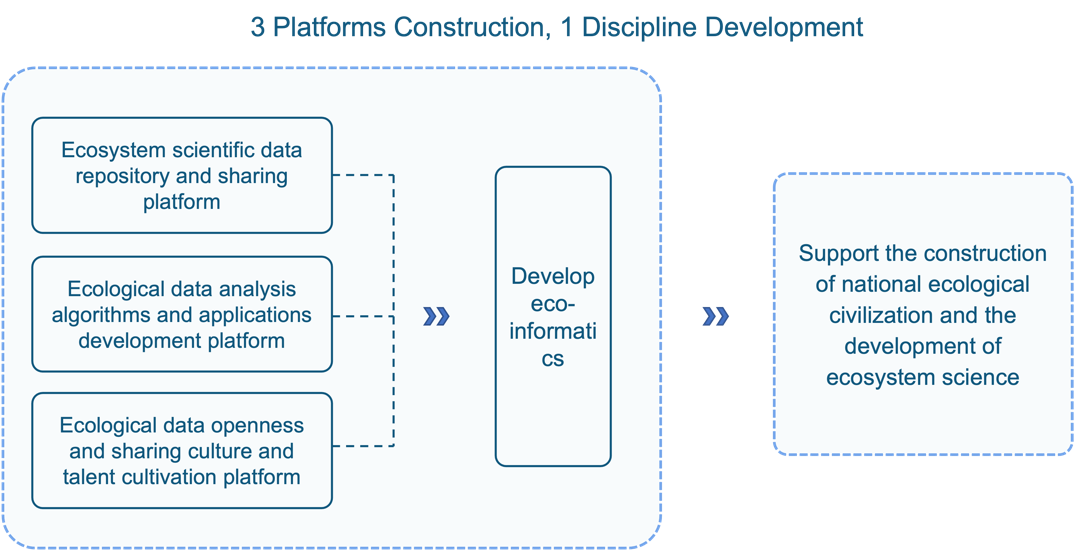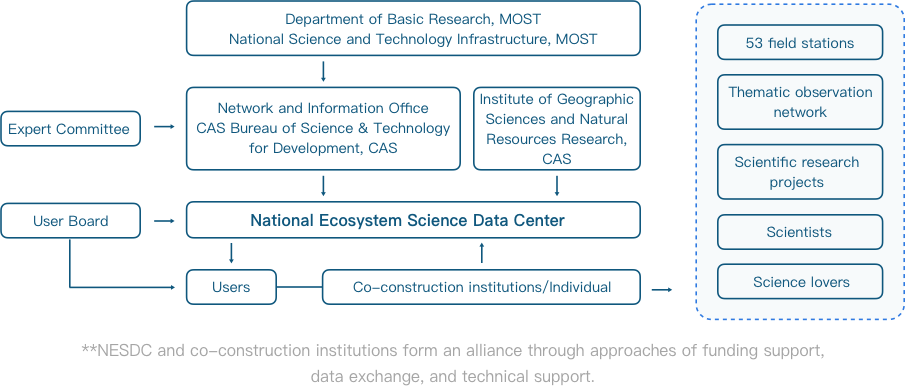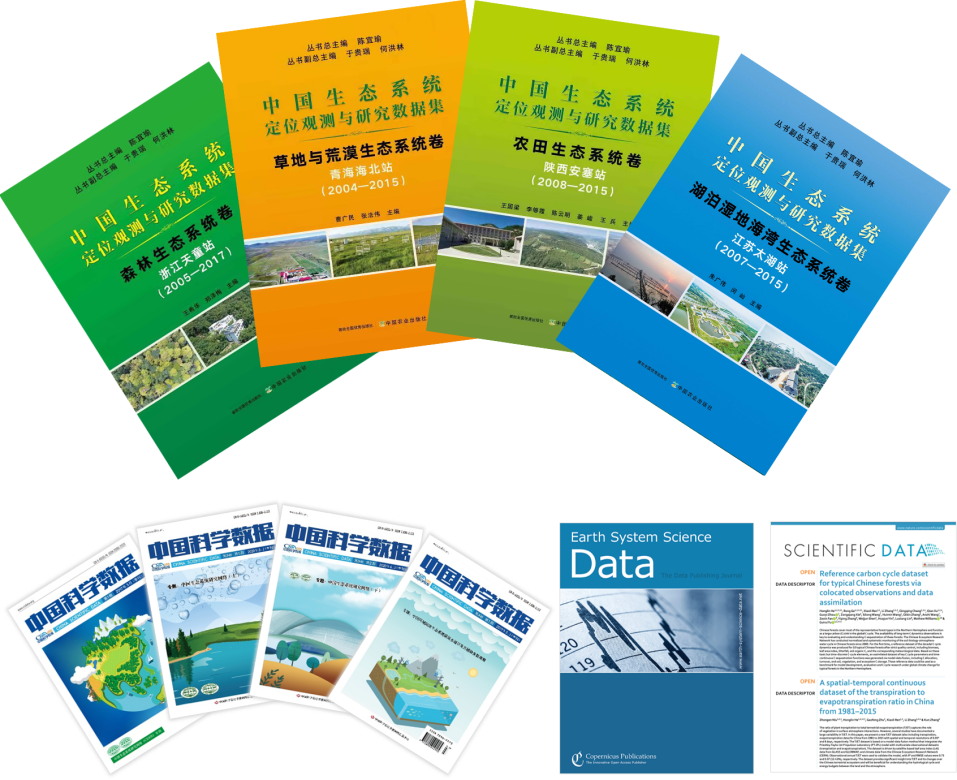National Ecosystem Science Data Center

1. History
In June 2019, the Ministry of Science and Technology and the Ministry of Finance jointly issued an optimized name list for the service platforms of national science and technology infrastructure, and the National Ecosystem Science Data Center (NESDC) was on the list and signaled the official establishment of NESDC. The data center of the Chinese Ecosystem Research Network (CERN) was founded, the ecosystem science data center of the Chinese Academy of Sciences was established almost simultaneously. In August 2019, the implementation plan of NESDC from 2020 to 2025 was approved by NESDC experts committee.
The predecessor of NESDC is the data center of National Ecosystem Research Network of China (CNERN), which belongs to the National Science and Technology Infrastructure certificated by the Ministry of Finance and the Ministry of Science and Technology in 2011.
2. Vision
Based on the national field stations of CNERN and other federal field stations as well as some thematic observation networks, with ecosystem observation and research data as its core, NESDC will integrate and develop station-region-nation-wide ecosystem observation and research data products, will strive to become an advanced science data center nationally and internationally, so as to support the construction of national ecological civilization and the development of ecosystem science.

The vision of NESDC.
3. Overall Goals
Basing on doing research and practicing on theories, methods, technologies, and standards of ecological data management, and taking advantage of advanced technologies such as AI, big data, and IoT, NESDC aims to build ecological data repository and sharing platform, ecological data analysis algorithms and applications development platform, to become a base of ecological data openness and sharing culture and talent cultivation, and to become an advanced science data center within domestic and international scopes to support the development of ecosystem science and the construction of national ecological civilization.
NESDC actively expands the types of data sources rather than stopping at its original base, which includes field stations of the Chinese Ecosystem Research Network and the National Ecosystem Research Network of China. It promotes ecological field stations at all kinds of levels, thematic observation networks, science and technology projects and research teams of ecology and related fields to submit their data to NESDC. And it promotes the researches and practices about ecological data sharing, product development, data mining and data analysis application so as to maximize the value of data through providing data service and knowledge service for all society.
4. Organization and Responsibility
The Ministry of Science and Technology is the highest authority of NESDC
The Network and Information Office of CAS, as well as the Bureau of Science & Technology for Development of CAS, are responsible for leading and supervising of NESDC
Institute of Geographic Sciences and Natural Resources Research, CAS which is the supporting institution, is responsible for leadership, supervision and support for NESDC
The experts committee is responsible for guiding NESDC's development direction, reviewing and consulting NESDC implementation plan
NESDC is responsible for the development of data protocols and standards, as well as for data integration, data analysis, data reprocessing, and data sharing
The co-construction institutions are responsible for obtaining in-situ observational data and conducting scientific research
The user board participates in the trial and evaluation of NESDC's platforms and applications, and give their feedbacks to NESDC

The organization and responsibility of NESDC.
5. Main Tasks
To establish a series of ecological data protocols and standards throughout the data lifecycle
To form a series of data product with typical ecosystems' long-term in-situ observational data as the core
To build a multi-source heterogeneous ecological repository covering field stations, thematic observation networks, science and technology program, journal papers, scientific research institutions/teams/individuals, and form a platform for submitting and sharing service
To build ecological data analysis, assimilation algorithms and tool libraries to form the ecosystem science data analysis and public service platform
To establish columns or sub-journals of ecological science data papers to promote data publication and data intellectual property protection
To organize the publication of annual data reports to support the compilation of regional / national ecosystem assessment reports
To organize training activities regularly to improve cultural circumstance of data opening and sharing, and consolidate education of graduate students in eco-informatics
To develop international cooperation with NEON, ECN, GEO, etc. to increase international influence
6. Center Profile
6.1 Data Resource System
NESDC has accumulated a large amount of high-quality ecological data, and has built a data resource system with ecosystem observation and research data as the core, containing 10 categories and more than 40 sub-categories. It has nationwide ecosystem long-term in-situ observational data for nearly 30 years, characteristic data from thematic observation networks, the largest ecosystem carbon attribute survey data in China, model-based simulation data for national/regional ecosystem dynamic changes, etc. The data volume in NESDC has reached dozens of terabytes with up to 85 million data records.

The data resource system of NESDC.
6.2 Data Production and Publication
NESDC continuously promotes data quality control, production and processing, and organizes data publication in a lot of ways, including dataset book series, atlas, data papers, etc. And at the same time, it does research on data mining and application. It has developed some data product production tools. They have been used by researchers to generate related data products and then to publish data papers and research papers on influential journals. These accomplish the value adding from data to information and then to knowledge.

The data publication of NESDC.
6.3 Informatization Construction
NESDC has 360 square meters of modular machine room, containing 87 physical servers, more than 200 virtual machines and other IT infrastructure. And it has developed Eco-Cloud platform, which has the functions of data submission, storage, management, and sharing. Furthermore, by using advanced technologies such as big data, cloud computing, IoT, and AI, NESDC develops field station data comprehensive management system and promotes its deployment in field stations, and develops data assimilation and ecological prediction system. NESDC is becoming a data center supporting the complete data lifecycle from data collection to data analysis.

Framework of Eco-Cloud platform.

Field station data comprehensive management system.

Figure 7. Data assimilation and ecological prediction system.
6.4 Service Efficiency
NESDC website traffic has been up to 31.23 million times, and the downloads are more than 53 TB. It has provided data services for about 1,300 scientific research teams and more than 40,000 people, and supported more than 1,600 projects. Meanwhile, NESDC conducts various research to serve the country and administrative departments, which make important contributions to China's ecological civilization construction. Research areas cover:
Networking multi-site long-term observational data mining;
Single site long-term observational data mining;
Developing methods such as ecological data scale expansion and ecosystem process model based on deep learning;
Assessing the amount, trend, and inter-annual change of terrestrial carbon and water flux in China;
Prediction of carbon sources and sinks of terrestrial ecosystem in China, etc.
6.5 International Exchanges and Cooperation
NESDC actively carries out international cooperation and academic communications to enhance its international influence. It has become a member node of DataONE. And some of its staff serve in international organizations such as ILTER and AsiaFlux.
Contact Us
Director of NESDC:
Prof. Honglin He
Email: hehl@igsnrr.ac.cn
Contact Information of NESDC:
Tel: 010-64889273
Email: nesdc@igsnrr.ac.cn
URL: http://www.nesdc.org.cn/
Address: Institute of Geographic Sciences and Natural Resources Research, Chinese Academy of Sciences, 11A Datun Road Chaoyang District, Beijing, 100101

WeChat Official Account